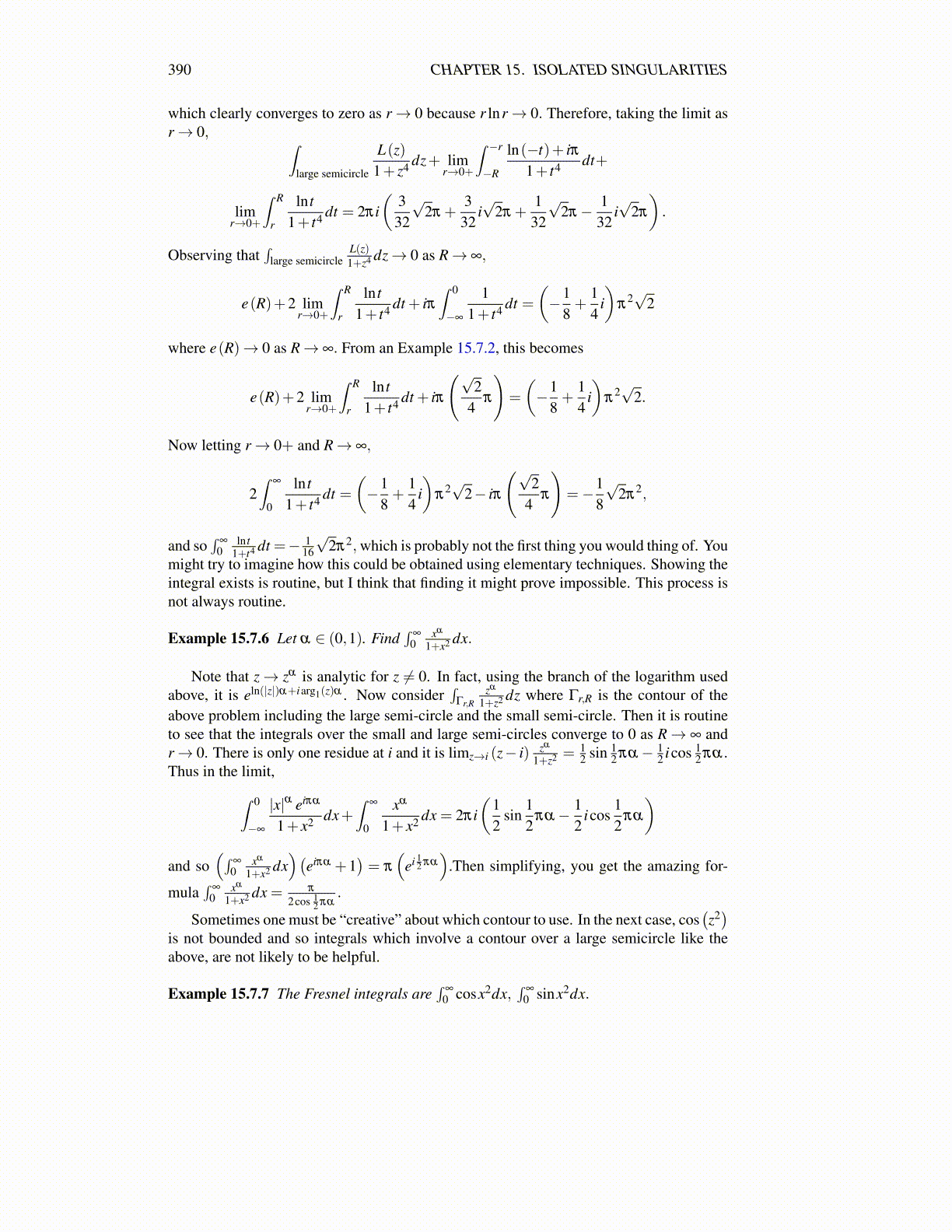
390 CHAPTER 15. ISOLATED SINGULARITIES
which clearly converges to zero as r→ 0 because r lnr→ 0. Therefore, taking the limit asr→ 0, ∫
large semicircle
L(z)1+ z4 dz+ lim
r→0+
∫ −r
−R
ln(−t)+ iπ1+ t4 dt+
limr→0+
∫ R
r
ln t1+ t4 dt = 2πi
(332
√2π +
332
i√
2π +1
32
√2π− 1
32i√
2π
).
Observing that∫
large semicircleL(z)1+z4 dz→ 0 as R→ ∞,
e(R)+2 limr→0+
∫ R
r
ln t1+ t4 dt + iπ
∫ 0
−∞
11+ t4 dt =
(−1
8+
14
i)
π2√
2
where e(R)→ 0 as R→ ∞. From an Example 15.7.2, this becomes
e(R)+2 limr→0+
∫ R
r
ln t1+ t4 dt + iπ
(√2
4π
)=
(−1
8+
14
i)
π2√
2.
Now letting r→ 0+ and R→ ∞,
2∫
∞
0
ln t1+ t4 dt =
(−1
8+
14
i)
π2√
2− iπ
(√2
4π
)=−1
8
√2π
2,
and so∫
∞
0ln t
1+t4 dt =− 116
√2π2, which is probably not the first thing you would thing of. You
might try to imagine how this could be obtained using elementary techniques. Showing theintegral exists is routine, but I think that finding it might prove impossible. This process isnot always routine.
Example 15.7.6 Let α ∈ (0,1). Find∫
∞
0xα
1+x2 dx.
Note that z→ zα is analytic for z ̸= 0. In fact, using the branch of the logarithm usedabove, it is eln(|z|)α+iarg1(z)α . Now consider
∫Γr,R
zα
1+z2 dz where Γr,R is the contour of theabove problem including the large semi-circle and the small semi-circle. Then it is routineto see that the integrals over the small and large semi-circles converge to 0 as R→ ∞ andr→ 0. There is only one residue at i and it is limz→i (z− i) zα
1+z2 = 12 sin 1
2 πα− 12 icos 1
2 πα.Thus in the limit,∫ 0
−∞
|x|α eiπα
1+ x2 dx+∫
∞
0
xα
1+ x2 dx = 2πi(
12
sin12
πα− 12
icos12
πα
)
and so(∫
∞
0xα
1+x2 dx)(
eiπα +1)= π
(ei 1
2 πα
).Then simplifying, you get the amazing for-
mula∫
∞
0xα
1+x2 dx = π
2cos 12 πα
.
Sometimes one must be “creative” about which contour to use. In the next case, cos(z2)
is not bounded and so integrals which involve a contour over a large semicircle like theabove, are not likely to be helpful.
Example 15.7.7 The Fresnel integrals are∫
∞
0 cosx2dx,∫
∞
0 sinx2dx.